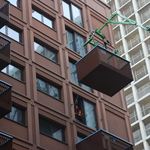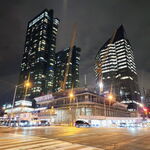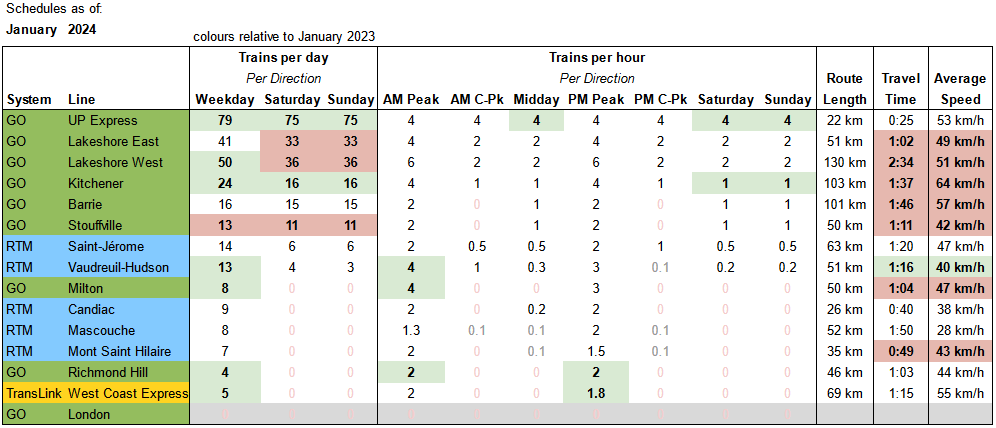Throughout 2023, many Canadian commuter rail lines saw modest increases in service, bringing many back to pre-pandemic service levels. One line is now far exceeding its pre-pandemic service.
Frequency
In March, the Barrie and Stouffville lines lost all of their off-peak train service, in an effort to speed up construction on both lines. Off-peak service was gradually restored on both lines in August, with full service on the Barrie line resuming in September. However, the Stouffville line never regained its evening train service, presumably to facilitate construction on the Highland Creek bridge which has been delaying the activation of the second mainline track between Kennedy and Unionville stations.
The UP Express has now finally been restored to pre-pandemic service levels. In February, off-peak service was improved to every 15 minutes, and in January 2024, late-evening service is being restored.
Once again the GO Transit Kitchener line has been the biggest winner when it comes to service improvements. In March an additional weekday peak period express train was added between Kitchener and Toronto, but the big news was that weekend train service was finally introduced, with hourly service from Toronto Union station to Brampton Mount Pleasant station. This now makes the Kitchener line the 4th line in Canada with hourly or better service all day every day. The new weekend service was so popular that the connecting buses from Bramalea to Kitchener and Waterloo became massively overcrowded, commonly leaving dozens of people behind. GO started adding unscheduled buses to help manage some of the overcrowding but it wasn’t until September that a real solution was implemented. GO has now vastly increased the bus service from Bramalea to Waterloo, with three double-decker buses scheduled to meet each train during busy periods.

Another source of overcrowding has been the rise of bicycle courier commuting between Brampton and Toronto. Evening trains on the Kitchener Line were packed full of e-bikes due to people going home after working downtown for delivery services such as Uber Eats. In September GO added an additional evening departure, and in October they added bicycle coaches to some evening trips.
On the Lakeshore West line, off-peak weekday express train service to Niagara Falls was introduced in May with two additional round trips per day. Weekday train service to Niagara had previously only operated in peak periods in the peak direction.
In October, the GO train service from Kitchener to London was permanently cancelled, as I described in
my previous post.
Many other lines gained one or two daily round trips during the peak periods in response to an increase in commuter demand, including the West Coast Express in BC.

Most lines are now roughly at the same frequency as they were prior to the pandemic. The only line with more service is the Kitchener line, which now has 32% more train service than in 2019, largely due to the introduction of weekend service. The most notable services which have yet to be restored are the 15-minute weekday midday train service on the Lakeshore lines between Oakville and Oshawa. Hopefully that service will be reintroduced in 2024, since the Milton Line has now lost its direct bus service to downtown, with buses being instead truncated at Lakeshore West stations.

Speed
There has not been much good news in terms of average speed this year. Most lines gained a minute or two of travel time to account for higher passenger volumes and thus longer dwell times at station. This in itself is to be expected, but it is concerning to note that most lines are now slower than they were in 2019, even though peak period ridership is lower. In the case of the Lakeshore East line, this is largely attributable to the loss of express service due to Ontario Line subway construction, but the remainder of services are taking longer to serve the same stops.
In October, Old Elm station (formerly Lincolnville) was relocated a few hundred metres to the south, avoiding the need for trains to crawl through Lincolnville Yard to reach the platforms. This should cut a minute or two off the trip, yet the line is now a minute slower than it was last year, though it is still two minutes faster than pre-pandemic.
GO Transit has been
promoting a 10-minute travel time improvement on the Milton Line starting in January, but this doesn’t represent an improvement compared to last year, it simply marks the resolution of a 10-minute delay that had been occuring for a few months due to track conditions. The “improved” Milton Line service is still 2 minutes slower than last year and 4 minutes slower than pre-pandemic.








